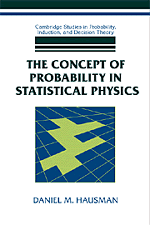Book contents
- Frontmatter
- Contents
- Introduction
- Chapter 1 The Neo-Laplacian Approach to Statistical Mechanics
- Chapter 2 Subjectivism and the Ergodic Approach
- Chapter 3 The Haar Measure
- Chapter 4 Measure and Topology in Statistical Mechanics
- Chapter 5 Three Solutions
- Appendix I Mathematical Preliminaries
- Appendix II On the Foundations of Probability
- Appendix III Probability in Nonequilibrium Statistical Mechanics
- Author Index
- Subject Index
Introduction
Published online by Cambridge University Press: 12 November 2009
- Frontmatter
- Contents
- Introduction
- Chapter 1 The Neo-Laplacian Approach to Statistical Mechanics
- Chapter 2 Subjectivism and the Ergodic Approach
- Chapter 3 The Haar Measure
- Chapter 4 Measure and Topology in Statistical Mechanics
- Chapter 5 Three Solutions
- Appendix I Mathematical Preliminaries
- Appendix II On the Foundations of Probability
- Appendix III Probability in Nonequilibrium Statistical Mechanics
- Author Index
- Subject Index
Summary
Probabilities have a puzzling character within the context of classical physics. Here, unlike in quantum mechanics, the use of probabilistic reasoning is not based on the existence of indeterminacy or objective lawlessness. Indeed, indeterminacy, in general, has no place in classical physics. In the very foundation of classical physics we find the assumption that, given the precise state of the world in one instance, the laws of physics determine its future states completely. Therefore, the introduction of probabilities into classical physics presents a problem. How are we to interpret statements from statistical physics whose abstract form is “The probability of A is p.”? Do probabilistic statements form an integral part of the description of the physical world? Do they merely reflect our ignorance with respect to the precise state of the world? Can they be deduced from nonprobabilistic statements? Can they be understood in terms of frequencies? This book is dedicated to the study of these questions.
Readers who are not very familiar with statistical mechanics may want a few examples of physical statements using probabilities. The following is a list of statements, written in plain English, expressing physical truths (classified under the heading of thermodynamics) whose precise formulation requires probabilistic concepts:
Water freezes at zero centigrade.
When two bodies are in contact with one another, the heat flows from the warmer body to the colder one.
When you heat a container full of gas, the pressure on the walls of the container will increase.
[…]
Information
- Type
- Chapter
- Information
- Publisher: Cambridge University PressPrint publication year: 1999
